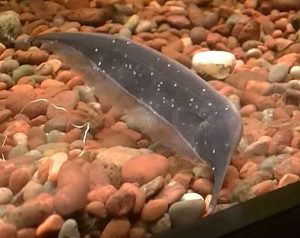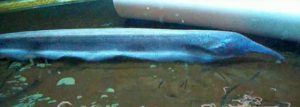The Elephantnose Knifefish (Sternarchorhynchus oxyrhynchus) is one of 32 known species of knife fishes in the Sternarchorhynchus genus that is found in the slow moving tropical South American rivers, streams, and tributaries of Venezuela, the Guaianes, and the Amazon River, in Brazil.
Elephantnose Knifefish have have poor vision and are a relatively peaceful, largely nocturnal species that inhabit the dark muddy riverbeds and heavily vegetated areas where they feed on worms, small crustaceans, and other foods found along the bottom as they root around the substrate.
Although they are not aggressive to other species, they are territorial with others of their own kind.
The body of the Elephantnose Knifefish is a light gray to an almost black color.
They have a long, thin, elongated body with an anal fin that runs the entire length of the fish, pelvic fins located just behind the gills, and an almost comical looking, long, downward pointing, fleshy “nose” or proboscis, that they use to burrow around in the substrate for worms. Sexing is next to impossible.
Elephantnose Knifefish are a scaleless species that emit a weak electrical charge that they use to locate food and possibly others of their own kind.
Because of the weak electrical charges they occasionally emit, they should not be mixed with other bottom dwelling species in an aquarium environment or with others of their own kind, especially in small tank.
The Elephantnose Knifefish is best kept alone in a single species biotope environment. Although some tropical fish keeping enthusiasts have successfully kept them with other knife fish species, they are generally intolerant to others of their own species.
Sternarchorhynchus oxyrhynchus do best in a large, densely planted aquarium of at least 55 gallon capacity, with a mud or sandy substrate, a few pieces of driftwood or bogwood, some smooth river rock made into caves for hiding, and some floating plants
to diffuse overhead lighting and provide additional security to the fish.
Because they are nocturnal, they need minimal lighting, so low light loving plants like Java Fern, Java Moss
, Anubias spp.
and Vallisneria can be used to aquascape the tank.
When exposed to bright aquarium lighting, Elephantnose Knifefish become withdrawn and will eventually quit eating and waste away. They should never be kept in a tank with a gravel substrate.
Elephantnose Knifefish are extremely sensitive to water quality and require a good filtration system with regular water changes to keep them healthy. Like most scaleless species, they are also sensitive to salt and most aquarium medications.
To date, no successful spawning has occurred in an aquarium environment.
Elephantnose Knifefish can be fussy about eating. They relish live tubifex but will also eat bloodworms, small or chopped up earthworms, live brine shrimp, and blackworms.
They can be weaned to accept frozen bloodworms, blackworms, or brine shrimp but live foods should be provided when they quit eating. Because they are largely nocturnal, it is best to feed them just before you turn the lights out on the tank at night.
Elephantnose Knifefish (Sternarchorhynchus oxyrhynchus) are rare in the aquarium trade but can be occasionally found online from wholesalers or from specialty tropical fish keeping shops.
Minimum Tank Size: 55 gallons
Care Level: Moderate
Temperament: Peaceful
Aquarium Hardiness: Delicate
Water Conditions: 73-82° F, 6-12 °d, pH 6.5-7.0
Max. Size: 20″
Color Form: Gray, Black
Diet: Carnivore
Compatibility: Single species tanks
Origin: Venezuela, the Guaianes, Brazil
Family: Apteronotidae
Lifespan: 8-12 Years
Experience Lever: Advanced




